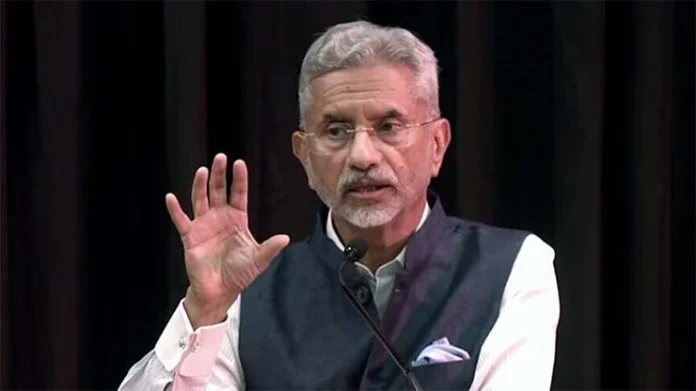&It is not usual for India to fluster China in its own backyard in the Southeast Asian region. But recently, External Affairs Minister S Jaishankar deliberately chose to do so to unsettle China when he extended support to the Philippines for upholding its sovereignty on the South China Sea, hinting at India’s assertive approach towards the region in the fast-changing geopolitical situation in the world.
“We are convinced that the progress and prosperity of this region is best served by staunch adherence to a rules-based order. UNCLOS 1982 is particularly important in that regard, as the constitution of the seas. All parties must adhere to it in its entirety, both in letter and in spirit. I take this opportunity to firmly reiterate India’s support to the Philippines for upholding its national sovereignty.” Jaishankar said while holding a joint press conference with his Filipino counterpart Enrique A Manalo on March 26 in Manila during his two-day visit to the Philippines.
Motive behind India’s support
It was not the first time when India extended support to the Philippines over the South China Sea dispute. In June 2023, changing its position for the first time, India advocated for compliance with the UNCLOS and the 2016 international tribunal award on the South China Sea.
While raising its voice of support for Manila again, New Delhi sent a tacit message to Beijing that it should refrain from sabre-rattling in the marginal sea of the Western Pacific Ocean.
It is not usual for India to fluster China in its own backyard in the Southeast Asian region. But recently, India deliberately chose to do so when EAM Jaishankar extended support to the Philippines for upholding its sovereignty on the South China Sea
This year in March, the Philippines coast guard accused the Chinese coastguard of “reckless and illegal actions” in the South China Sea after the latter rammed a Philippines vessel, resulting in minor structural damage to the ship.
In the same month, Manila protested strongly after two Chinese coast guard ships sprayed water cannons at a Philippine navy-operated supply boat near the disputed Second Thomas Shoal in the South China Sea. The incident had resulted in injuries to Filipino Navy crew and severe damage to their vessel in the South China Sea.
Since last year hostilities between Manila and Beijing over the South China Sea have increased. Till October 2023, according to the Philippines Foreign Ministry, Manila had lodged diplomatic protests as many as 55 times against Beijing for Chinese navy and coast guard’s continuous harassment of the Philippines coast guard in the South China Sea.
Japan and the US have extended their strategic support to the Philippines in standing firm against China’s threat, but India’s support to Manila on the South China Sea is seen as having a deeper meaning.
Firstly, by extending support to Manila, India wants to fight off China’s whims on the territorial matters. It is feared that if China remains successful in coercing less powerful regional actors to concede on territorial claims, Beijing, emboldened by its move, may turn more aggressive in its territorial disputes with India.
If that happens, New Delhi may have no option but to be aggressive in equal proportion or more, in fighting off China’s designs along the LAC. However, neither China nor India will like to escalate tension beyond some limits, as it will greatly impact their respective rise globally.
While raising its support for Manila again, New Delhi sent a tacit message to Beijing that it should refrain from sabre-rattling in the marginal sea of the Western Pacific Ocean
Secondly, the move to support Manila on the South China Sea, which is claimed entirely by Beijing under its imaginary ‘Nine-dash line.’ will help India in deepening its influence on strategic and security fronts in the ASEAN region, which is regarded as the central pillar of the country’s Act East policy.
Thirdly, while helping the Philippines in defending its maritime claims against China’s encroachment in the South China Sea, India in a way advances its own strategic ambition to stave off Chinese military power in seas closer to the Indian Ocean.
Rise in India’s strategic confidence
Its heft in economic and global profile has provided India some valid reasons to have strategic confidence in challenging China’s dominance in the region. In this regard, Beijing has itself accepted this reality.
“With its rapid economic and social development, India has become more strategically confident and more proactive in creating and developing Bharat narrative.” Zhang Jiadong, Director of the Centre for South Asian Studies at Fudan University said in his column in Global Times on January 2 this year.
Japan and the US have extended their strategic support to the Philippines in standing firm against China’s threat, but India’s support to Manila on the South China Sea is seen as having a deeper meaning
He further commented: “India is indeed a major power, and rapid changes in its internal and external strategies pose challenges to both itself and the international community. It appears that a transformed, stronger, and more assertive India has become a new geopolitical factor that many countries need to consider.”
India has resolutely stood up to China’s coercion on eastern Ladakh and Arunachal Pradesh. In June 2020, when the world was grappling with Covid-19 triggered pandemic, China had carried out an unprovoked attack on India at Galwan to show the international community, especially the US and rest of the Indo-Pacific that India was unable to manage its own security at its frontiers.
The attack was meticulously planned and foxily executed by the Chinese PLA to demean and humiliate India and to show the world that New Delhi would not be relied upon to bolster deterrence in the Indo-Pacific, or to be a net security provider in the Indian Ocean region.
But nearly four years have passed since the deadly fracas between Indian soldiers and Chinese PLA personnel at the Galwan Valley, India has not withdrawn a single soldier from the country’s border facing China.
Overall, India’s support to the Philippines on its claims on the South China Sea has links with New Delhi’s military aspirations; India has been assisting Manila in strengthening its military capabilities through the sales of missiles and other defence hardware
Instead, a unit of 10,000 soldiers that was previously sent to the western front has been deployed to guard a strategically important stretch of the Indo-China border in Uttarakhand and Himachal Pradesh. Such deployment of troops – backed by their own dedicated artillery and air support – to this stretch, has unnerved China.
“India’s move of strengthening military deployment along the border with China is counterproductive to the two countries’ effort to ease the situation at the border and not conducive to safeguarding peace and tranquillity of the border areas.” Chinese Foreign Ministry Spokesperson Mao Ning said during a press briefing on March 8.
Overall, India’s support to the Philippines on its claims on the South China Sea has links with New Delhi’s military aspirations; India has been assisting Manila in strengthening its military capabilities through the sales of missiles and other defence hardware.
In February 2024, India began delivery of its Brahmos supersonic cruise missiles to the Philippines, after New Delhi and Manila signed a $375 million deal in 2022 for the supply of three batteries of the missiles.
These developments show India’s ambitious move to expand its strategic and security profile beyond the Indian Ocean region and align with all those countries, which feel threatened by China’s expansionist designs
In December 2023, navies of India and the Philippines carried out a maritime exercise in the South China Sea. Last month, in the midst of tension in the South China Sea, the Indian coast guard ship, ‘Samudra Pahredar’ docked at the Manila Port.
These developments show India’s ambitious move to expand its strategic and security profile beyond the Indian Ocean region and align with all those countries, which feel threatened by China’s expansionist designs. It also reflects India’s determination to chart out an independent strategy to expand its outreach among nations, which are not resourceful and powerful to challenge assertive China in the Indo-Pacific region.
–The writer is a senior journalist with wide experience in covering international affairs. The views expressed are of the writer and do not necessarily reflect the views of Raksha Anirveda
–The writer is a senior journalist with wide experience in covering international affairs. The views expressed are of the writer and do not necessarily reflect the views of Raksha Anirveda

















